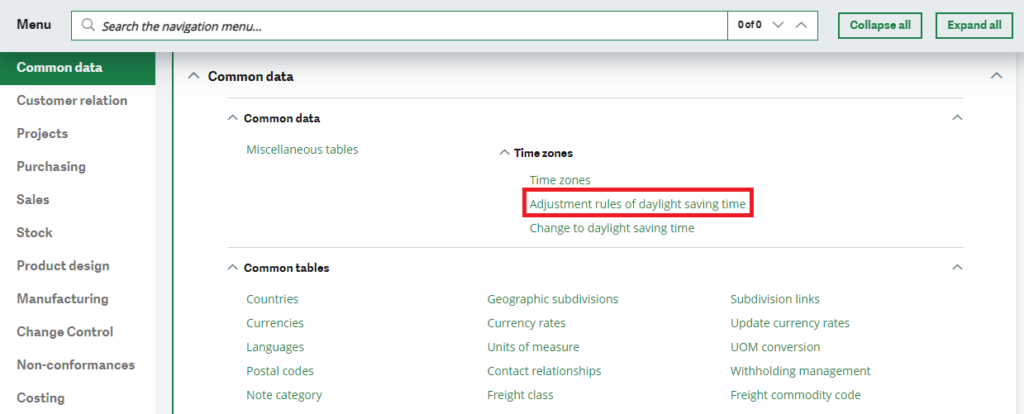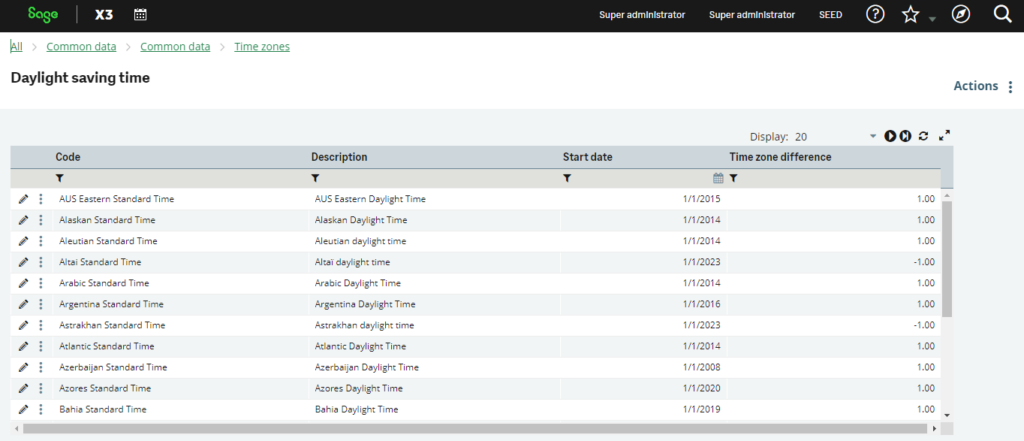In Sage X3, adjustment rules for daylight saving time (DST) typically involve configuring the system to automatically adjust for changes in time when DST begins or ends. This ensures that date and time calculations within the system remain accurate despite the shift in local time.
Utilize this feature to establish transition guidelines for Daylight Saving Time (DST) across various global time zones.
Global time zones serve to convert dates and times transmitted to the Production Scheduler into the standard time reference “UTC” (Coordinated Universal Time).

Navigate to:
Common data -> Common data -> Time zones -> Adjustment rules of daylight saving time

For creation, we need to select Create button from action or you can edit the rule from previous created rules.
The regulations governing the commencement and conclusion of Daylight Saving Time (DST) can vary, with changes occurring annually in some time zones. To ensure accurate conversion between time zones and UTC for Production Scheduler, you must input and update time zone details using a specified procedure. This involves adhering to the following sequence of steps:
1. Establish global time zones within the Time zones function (TIMEZONEINFO).
2. Once configured, set the PSTIMEZONE – Server time zone parameter (found in the EXAPP chapter, MIS group) to the time zone where your server is located.
3. Specify Daylight Saving Time (DST) transition guidelines for global time zones in the Change to daylight saving time function (TIMETRANS).
4. Define the transition rules for Daylight Saving Time (DST) within this function (TIMEADJUST).

Importance of every field has elaborated below:
Code:
This field serves to designate a time zone identifier. It must correspond to the name of a time zone specified in the Daylight saving time field (TADCOD) within the Time zones function.
A time zone identifier typically denotes the local time of a region or country. For instance, “ACWST” or “Aus Central W. Standard Time”.
Description:
This field is utilized to provide a description of Daylight Saving Time (DST) for the respective time zone. It may include the time zone identifier along with a seasonal reference, such as “ACWST – Aus C W Std Summer” or “AUS Fall Central West Std Time”.
Start date:
This field is employed to define the effective date of this transition rule.
Time zone difference:
Input the number of hours the time will adjust by on the specified start date. If the time zone transitions to an earlier time, precede the figure with a minus sign (“-“).
Daylight saving time start:
This field is essential for defining a Daylight Saving Time (DST) transition rule code.
For example, a DST transition occurring on the 4th Monday of November at 03:00 am would be represented by the code NOV_MON_4_3. A change to DST at 02:00 am on the 4th of March indefinitely would be denoted by the code MAR_FXD_4_2.
Day of the week:
This field automatically displays the day of the week when the transition takes place, based on the selected Daylight saving time start (TTRCODSTR) transition rule.
Month:
This field automatically displays the month when the transition occurs, based on the selected Daylight saving time start (TTRCODSTR) transition rule.
Time:
This field automatically displays the time of day when the transition happens, based on the selected Daylight saving time start (TTRCODSTR) transition rule.
Week:
This field automatically displays the week of the month when the transition occurs, based on the selected Daylight saving time start (TTRCODSTR) transition rule.
Daylight saving time end:
This field is necessary for defining a Daylight Saving Time (DST) transition rule code for the end of DST.
For instance, a DST transition on the 4th Monday of March at 03:00 am would be represented by the code MAR_MON_4_3. A change to DST at 02:00 am on the 4th of November indefinitely would be denoted by the code NOV_FXD_4_2.
Similar to TTRCODSTR, even if the time zone does not transition to DST, a transition rule code must be defined. This can be a fixed code like JAN_FXD_1_0, indicating a permanent (non-) change to DST occurring on the 1st of January at midnight.
It’s crucial to follow the specific guidelines and recommendations provided in the Sage X3 documentation or consult with your system administrator to ensure that DST adjustment rules are correctly configured for your organization’s needs. Incorrect DST settings can lead to discrepancies in date and time calculations, potentially affecting various aspects of system functionality.

